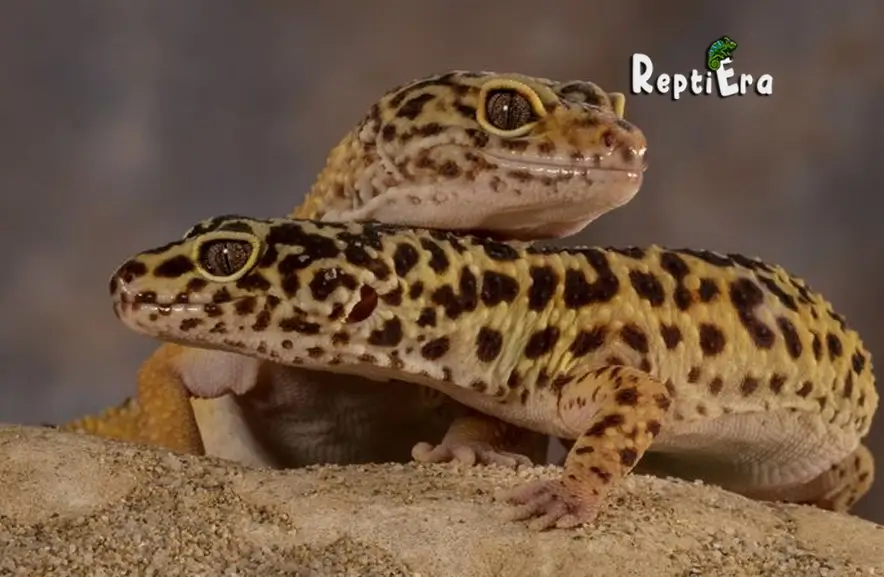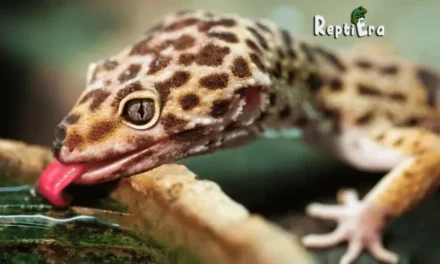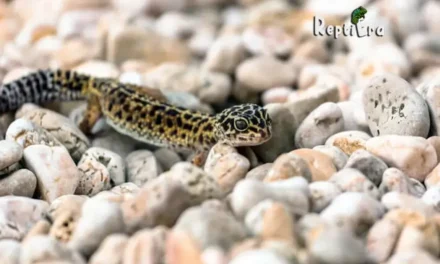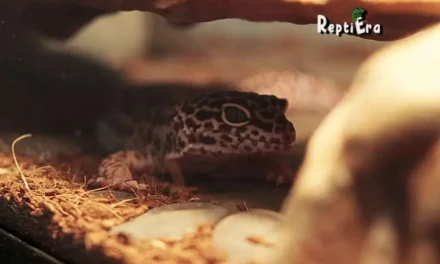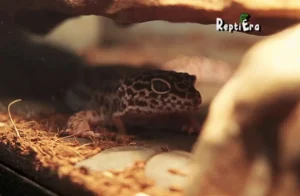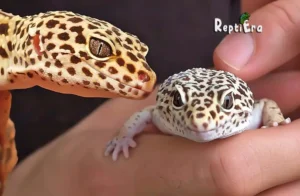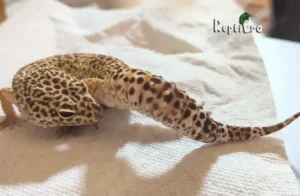Leopard Geckos are cute and easier to care for compared to many other reptiles, making them happy choices for keepers. When you consider getting a second Leo, perhaps inspired by YouTube videos or displays at your local pet store, the idea of them hanging out and sharing an enclosure might seem appealing. However, it’s important to understand whether it’s a good idea for them to live together.
Can Leopard Geckos Live Together?
These geckos are naturally solitary and can be territorial. While female pairs might coexist peacefully, a male and female, or two males, might fight, potentially leading to fatal injury. Therefore, it’s advisable to avoid cohabitating with them whenever possible.
In specific situations, with experienced care and understanding of pairing, two females might coexist, but this requires a closer look at their individual behaviours. For those new to leopard gecko care, understanding the background information on their natural instincts is vital. Despite their calm appearance, putting two geckos together without considering these factors is generally a bad idea. Each gecko should have its own space to thrive and exhibit natural behaviours without stress or conflict.
Table of Contents
Leopard Geckos Are Naturally Solitary Creatures…Which Makes Cohabing Hard
Unlike species that are naturally social and live in packs, like dogs, wolves, or bees, which have evolved to rely on group dynamics, Leopard Geckos originate from the rocky deserts of Asia and the Middle East where they have evolved to be solitary. This adaptation is akin to that of asocial animals like cats or polar bears, where competition for food, mates, and territory is vital for survival.
In their natural habitat, Leopard Geckos must frequently compete with other predators, such as foxes, and other reptiles for their little meals, fostering competitive instincts that are deeply rooted in their evolution.
In captivity, where their meals are hand-delivered and there is no need to compete, these instincts are hard-pressed to change. Leopard Geckos generally prefer to be alone, viewing other geckos as potential threats to their survival, especially if they are of the same sex. This is particularly true for male Leopard Geckos, who can be quick to start a fight over territory or resources. Their solitary nature makes cohabitation a challenging endeavour, requiring careful consideration and management by their keepers.
Gender Is The Biggest Factor In Leopard Gecko Cohabitation
In managing Leopard Gecko cohabitation, control over their solitary instincts is crucial, and the biggest factor in a successful pair is the sex of the geckos. When deciding which geckos can cohabitate, it’s essential to pick geckos of compatible genders, as their natural solitary tendencies can lead to conflict, especially among same-sex pairs. Understanding these instincts and carefully considering gender options are key steps in ensuring peaceful cohabitation among Leopard Geckos.
A male and a female
When considering whether male and female Leopard Geckos can live together, it’s important to note that they should be housed separately until they have matured to full size. This precaution is necessary because, during their growth phase, larger geckos might steal food from smaller ones, potentially stunting their growth.
Once they have reached maturity, the possibility of them living together depends on their individual temperaments and the breed. However, continuous monitoring is essential to ensure peaceful cohabitation. Special attention should be paid during the breeding season, as males can become aggressive. As a general rule, house hatchlings and juveniles separately to avoid competition and stress.
In the context of housing male and female leopard geckos together, it’s essential to consider their reproductive aspects. A female can produce eggs up to 8 times during a mating season, and repeated egg production can cause stress on her body, potentially reducing her lifespan. If your intent is to breed, you should be prepared for the influx of eggs and potentially, baby geckos. However, it’s generally advised to keep males and females separate unless breeding is the specific goal.
In breeding setups, it’s common to house a single male with several females, which can increase egg production but may also put strain on a single female. Therefore, the size of the tanks should be adjusted accordingly to accommodate these needs and to ensure the health and well-being of both males and females.
Related Post: HOW MANY EGGS DO LEOPARD GECKOS LAY
Male and Male
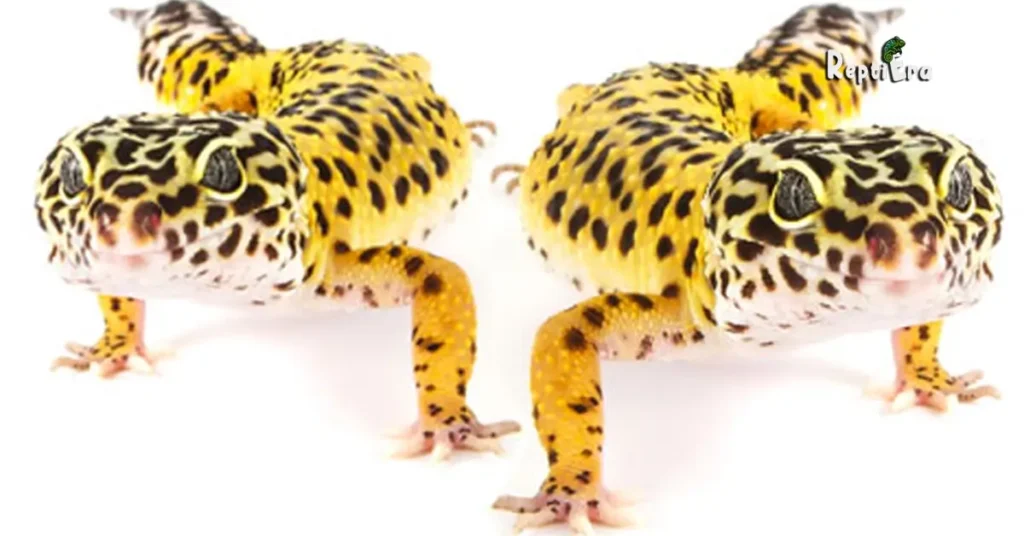
Pairing two male Leopard Geckos together is the absolute worst option and should be avoided 100%. These animals are very likely to fight, driven by their instincts to reproduce and protect their territory. Such battles can be over resources, hiding spots, or food, all of which are valuable in their eyes. Once stuck in the same enclosure, they will continue fighting, which can eventually lead to death due to stress or injuries. This is why it’s crucial to never pair two male Leopard Geckos, even if they’ve grown up together or seem like best friends; it almost always ends in death given enough time.
Female and Female
When considering the combination of female leopard geckos, there are no absolute guarantees, but it’s likely to work better compared to other pairings. While less prone to fight, these reptiles may still have the occasional conflict over resources. To ensure harmony, it’s crucial to make sure there is plenty of everything they need. This includes access to warmth, food, and hiding spots. A bigger enclosure can be instrumental in preventing these conflicts, allowing each leopard gecko enough space to thrive.
Note: Each species of leopard gecko has individual personalities that may vary. Some may get along seamlessly, while others might not tolerate sharing their space. It’s a delicate balance, and as a seasoned herpetologist, I’ve seen varying degrees of success and challenges with this setup. The key lies in observing their interactions and being ready to intervene or separate them if necessary. Continuously providing an environment that caters to their needs and respects their natural behaviour is essential for their well-being.
Other Factors To Consider When Putting Two Leopard Geckos Together
Although gender is often viewed as the primary consideration, it’s not the sole factor to consider. Let’s explore additional aspects that are also important.
#1 Relationship and History
In the context of leopard geckos cohabiting, their relationship and history play a pivotal role. Female leopard geckos that have been raised with each other from being born together have a higher chance of getting along compared to an adult pair that has never met. Clutch mates often exhibit more tolerant behaviour, making them a more likely perfect match than introducing two strangers. In contrast, males, regardless of their shared history, are more prone to fight, underscoring the complexity of their social dynamics.
#2 Enclosure Size and Available Resources
Creating an enclosure for one leopard gecko is relatively straightforward, but accommodating two leos requires more thought, particularly if you’re considering saving space. It’s crucial to balance the resources, ensuring multiple areas for hiding, basking, staying cool, and eating. Leopard geckos are asocial creatures and can become competitive, so it’s vital to limit opportunities for fighting by providing plenty of everything, especially hiding spaces.
Adhering to best practices in care, such as providing at least 3 hiding spots in both the warmer part and a cooler spot, with an optional humid spot for the shed, can make them feel more at ease. While it may seem a lot more work, housing two in a space double the size doesn’t necessarily mean it will be significantly more difficult. However, it does add to the worry about whether each gecko can claim something valuable to them.
In my experience, geckos have an overall better chance of getting along in an absolutely massive enclosure, compared to trying to squeeze them into something like a 5-gallon tank. Such an expansive environment reduces stress, allowing each gecko to establish its own territory and minimizes conflicts. This not only ensures their well-being but also makes monitoring and caring for them easier for the keeper. Remember, the key to success in cohabitating with leopard geckos lies in generous space allocation and resource distribution.
Also Read: HOW FAST IS A LEOPARD GECKO
#3 Size Of The Leopard Geckos
Regardless of how friendly leopard geckos may appear, they naturally compete for resources to an extent. A significantly larger gecko can dominate in terms of competition, especially when it comes to end goals like food and hunting a cricket. To compensate for the smaller size, keepers should count on providing environments where they can comfortably cohabitate. It is recommended to make sure the geckos are of a similar size to minimize dominance and ensure a more harmonious living arrangement.
#4 Sexual Maturity and Age
In reptiles like leopard geckos, sexual maturity is a critical factor, often determined by weight rather than age. Typically, they reach this stage between 18 months and 24 months or upon reaching around 35 grams. As juveniles, these geckos may exhibit less aggressive behaviours, but with hormonal changes, they can become more territorial and engage in mate-seeking activities.
This shift can disrupt the stability of a previously peaceful habitat.
Tip: For young geckos, cohabitation might seem harmonious initially, but as they mature, guaranteed problems can arise, especially among male geckos. This underscores the importance of understanding and monitoring their growth and behavioural changes over time.
Housing options for multiple leopard geckos
Living together
It can be safe for Leopard Geckos to live together under certain conditions. For example, a 3ft vivarium provides ample space for up to three Leopard Geckos to coexist comfortably. However, it’s essential to monitor their interactions regularly to ensure a harmonious environment, as Leopard Geckos can exhibit territorial behaviour. When setting up a shared habitat, it’s crucial to provide multiple hides and feeding areas to prevent competition and stress among the geckos.
(There are many good options available for a reasonable price on Amazon (and usually with free delivery).
For those seeking comprehensive advice on choosing the right vivarium for their Leopard Gecko, it’s essential to consider the size and features of the enclosure. A spacious and well-equipped vivarium is crucial for the health and well-being of these reptiles, whether they are housed alone or with a companion.
Tip: Proper heating, lighting, and hiding spaces are key elements to ensure a suitable and safe environment. Providing an appropriate habitat is fundamental to their care, and careful consideration should be given to these aspects when setting up your Leopard Gecko’s home.
Living separately
(If you need to house your leopard geckos separately, we’d recommend investing in a vivarium stack.)
For those who house more than one Leopard Gecko or other reptiles like bearded dragons, vivarium stacks offer a practical solution. These vivariums, stacked on top of each other, can comfortably provide each reptile with its own living space. This setup is a good space-saving solution for reptile enthusiasts who have 3-4 reptiles. It allows each gecko to have its own territory, reducing stress and potential conflicts that can arise from cohabitation. Properly managed, vivarium stacks can create a healthy and individualized environment for each of your reptiles.
Can A Baby Leopard Gecko Live With An Adult?
When considering the cohabitation of leopard geckos of different ages, particularly an adult and a baby, it’s important to recognize that this combination often does not work. Despite their generally social nature, adult leopard geckos may try to eat a smaller, younger gecko. They aren’t the smartest when it comes to recognizing what should go in their mouth, including another leo. While combining two babies might seem like a viable option, the risks associated with mixing a baby gecko with an adult are significant. This is especially true before they become sexually mature, as the size difference can lead to unforeseen dangers.
Putting Two Leopard Geckos Together May Not Save Much Space
While the idea of housing two leopard geckos in the same enclosure to save space might seem like one of the benefits, the reality often contradicts this expectation. The husbandry requirements for each gecko mean that the size of the enclosure needs to effectively accommodate both, which can render the notion of saving space ineffective. In fact, double the size of an enclosure for an individual leopard gecko is often required to provide sufficient hiding spots and comfort for both. Ironically, saving room can be more efficiently achieved through two enclosures, possibly utilizing shelving to maximize vertical space. This approach not only ensures adequate space for each gecko but also aligns better with their solitary nature.
Shared Housing Makes Monitoring Health More Difficult
Even if you successfully pair two leopard geckos, a significant worry arises with shared space – monitoring health becomes notably more difficult. For instance, discovering blood or a concerning stool in the enclosure leaves you puzzled about which of the two leopard geckos produced the poop or is responsible for the blood. Similarly, monitoring their appetite is challenging, as often one leopard gecko may dominate the majority of the food, leading to the other becoming skinnier and necessitating eventual separation. Effectively managing the health and well-being of cohabiting geckos thus requires a vigilant and careful approach.
Also Read: WHY DO LEOPARD GECKOS LICK THEIR LIPS
Things Can Change…Quickly
It’s a known fact among experienced herpers that even if you’re present to monitor your leopard geckos for most of the day, you can’t do so 24 hours a day, and a disaster can occur unexpectedly. They might be getting along well for days, weeks, or even months, but a sudden conflict over territory or food can escalate quickly, potentially leading to expensive veterinary bills or, in worst cases, the death of one of the geckos.
This reality adds not only stress to the geckos but also to the caretakers. Therefore, having an additional enclosure ready is advisable, particularly for instances where you need to closely observe their health, like monitoring bathroom breaks. This approach also dispels the myth of saving space by cohabiting with leopard geckos, highlighting the need for preparedness and constant vigilance in their care.
Do Leopard Geckos Need A Friend?

One of the last appeals for allowing leopard geckos to live together is the idea of preventing them from feeling lonely. However, it’s difficult to understand the feelings and emotions of these creatures, as they possess only a limited amount of emotional expression. It’s safe to say that leopard geckos, being asocial reptiles that have evolved to live alone, don’t get lonely. Their natural instinct is to survive without a tank mate of any species. In fact, housing leopard geckos together can often increase stress rather than reduce it, as they are not accustomed to or in need of companionship in their habitat.
Also Read: DO LEOPARD GECKOS CLIMB
So Are There Any Real Benefits Of Putting Two Leopard Geckos Together?
The question of whether there are any real benefits to combined housing of leopard geckos often leads to a complex assessment. While you might get some charming Instagram photos, the reality of keeping multiple geckos together tends to be more difficult than easier.
Adhering to best practices in husbandry requires ample space and diligent monitoring of each gecko’s eating habits and stools. Being vigilant to prevent any potential conflicts adds to the stress for both the geckos and the caretaker. These downsides often overshadow the perceived advantages, making it rare and generally not the best option for their well-being.
Leopard Geckos Living Together Vs Being Taken Out Together
While leopard geckos shouldn’t be housed together due to their territorial nature, taking them out together in a controlled environment can be a different story. The key difference lies in sharing the limited space of a vivarium versus the wide-open space of, say, a couch, where they might seem to think the area is limitless.
This freedom often leads to them walking or even falling off the couch, highlighting the need for constant supervision. Keeping an eye out for any potential conflict when they are out together is crucial, but it’s generally easier to intervene before anything happens. This approach allows them some level of interaction without the risks associated with permanent cohabitation.
FAQs
Can I keep two leopard geckos together?
Some keepers have attempted to house two female leopard geckos together, but this is often not worth the trouble and stress it entails. Ensuring an enclosure that is large enough for both geckos is crucial, yet even then, cohabitation can be challenging. Males and females shouldn’t be housed together unless you are prepared for or specifically want babies. Furthermore, males should never be paired in the same enclosure, as this almost invariably leads to conflict. The complexities of their social interactions make it clear that, in most cases, leopard geckos are better off living solo.
Can leopard geckos have roommates?
Asocial and solitary by nature, leopard geckos often fare best without roommates. Contrary to what one might think, they don’t view another gecko as a friend but rather as competition for already limited resources. Adding a Leo roommate typically leads to conflict, especially over essential needs like hiding spots, food, and other valuable resources within their habitat. Their inherent tendency to be alone means that even well-intentioned attempts at companionship can end up creating stress and disharmony in their environment.
Can you put 3 leopard geckos together?
Putting even two leopard geckos together is generally considered a bad idea, and increasing the number to three leopard geckos in the same enclosure is even worse. The presence of more geckos escalates the chances of fighting, as each tries to assert dominance over the others. This not only requires more space but also significantly prevents effective monitoring of each individual leopard gecko’s appetite and outputs. In such a crowded environment, it becomes almost impossible to ensure each gecko receives adequate food and remains stress-free, leading to potential health issues and heightened aggression among them.
Will two female leopard geckos fight?
In the spectrum of gender combinations, two female leopard geckos are the least likely to fight, yet this doesn’t mean such conflicts won’t happen. Unlike two males, where aggression is almost guaranteed, there have been instances where many keepers have successfully paired females. However, even with this seemingly more amicable pairing, it is still not a best practice to house them together. The inherent territorial nature and unpredictability in their behaviour mean that, while less frequent, the risk of disputes and stress-induced health issues in females still exists, making cohabitation a cautiously considered decision.
How many leopard geckos can live together in a 20-gallon tank?
It’s generally not a good idea to combine multiple leopard geckos in a single habitat, with the recommendation being one per enclosure, especially in a 20-gallon tank. While this size might provide enough space to combine females in some cases, it’s often not worth the risk of potential fighting. In a confined space like a 20-gallon tank, the limited area can lead to increased stress and territorial disputes, making it challenging to maintain a healthy and peaceful environment for the geckos. Therefore, for their well-being and to minimize conflict, it’s advisable to house each leopard gecko separately.
Conclusion
While it may be tempting to combine multiple leopard geckos in one habitat, upon considering the downsides, it becomes clear that it’s no longer a good idea. Most keepers find they are better off providing one enclosure per leopard gecko. This doesn’t mean you can’t take out your leopard geckos at the same time for supervised interaction, but it’s vital to watch for signs of conflict or stress. Being ready to intervene if a problem occurs is crucial, as leopard geckos, being solitary by nature, often exhibit stress or aggression when housed together. This approach ensures the well-being of each gecko while allowing occasional controlled social interaction.

